explore
Jungle Lowlands - Religion
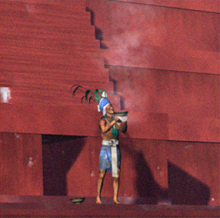
During the Classic Period (A.D. 250-950), the Maya invested tremendous labour and materials in religious activities. Rulers had both an administrative and a spiritual role in their society. Monumental temples and palaces were erected as architecture was employed as a medium for communication and a venue for ceremonial activities. Dynastic rulers used their perceived divinity and military might to control local populations and influence other regional polities. Gift giving, tribute and other forms of reciprocity were all aspects of the social currency.
Image: In this computer generated recreation of a temple scene a Maya priest, resplendent in his finery, offers prayers and copal (incense) smoke to the heavens.
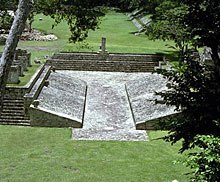
Common cosmological themes were enacted through ballplaying and ritualized dramatic performance, at times enhanced through the ingestion of various hallucinogenic substances. People communicated with their gods in various ways, among them ritual bloodletting, tributes, shrine worship and on occasion, human sacrifice.
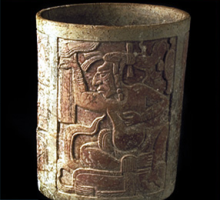
The scene depicted on the vase is of a diviner. In his right hand he raises a mirror, presumably used to see into the otherworld of spirits. To the Maya, this metaphysical world was as real as the physical one we occupy. Diviners or shamans often ingested natural hallucinogenic substances to allow them to enter this realm. The sensation, which today is understood clinically as an affect on the senses, was believed by the Maya to be actual transcendence into another realm. Through the mirror, which may have been made out of polished obsidian, the diviner could obtain guidance for his followers in the human realm. G83.1.113
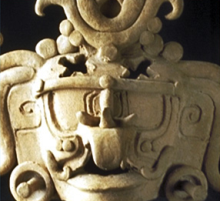
The various deities in the Maya pantheon had individual capabilities that were afforded greater or less reverence depending upon the occasion or the niche of a given community. Major gods who were more uniformly revered throughout the Maya world tended to be those linked with bounty and also disaster. Gods such as K'inich Ajaw (sun god) and Chaac (rain god) had the power to bring the sunshine and rain required for the agricultural surplus which supported the great city states of the Maya. They also had the power to muster famine-inducing droughts as well as devastating storms and floods. The reverence the Maya paid to these two gods in particular exemplifies the human relationship with the environment.
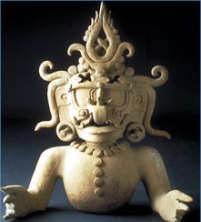
This bust represents K'inich Ajaw, the sun god of the Maya. An elaborate vessel, it used to have a lower section making it a full figure. Unfortunately, that section is missing. This vessel was likely found in a cache, a special burial area for objects (not people) commonly placed in association with monuments or structures.G83.1.78